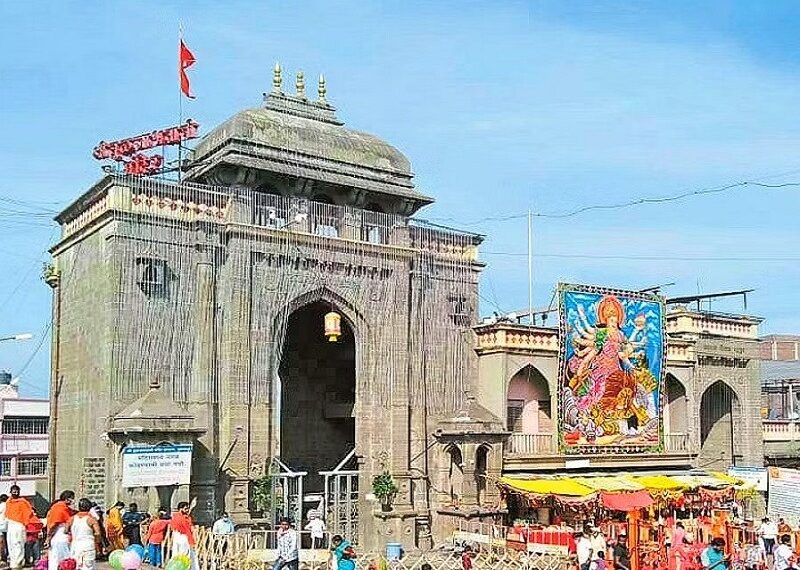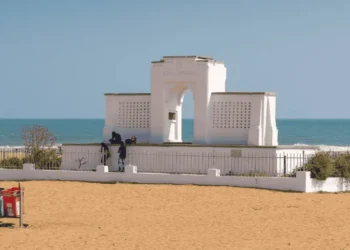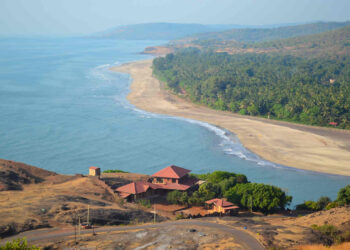Tulja Bhavani Temple in Tuljapur, Osmanabad district, dedicated to Goddess Bhavani, a fierce form of Shakti, is a revered shrine of faith. Set on a hill in the Balaghat range, about 25 km from Osmanabad, its stone carvings, serene vibe, and divine presence draw devotees and pilgrims from across India.
Mythological Importance
The Tulja Bhavani Temple carries deep legends. One story tells of a demon named Matanga, who troubled sages on this hill. Goddess Bhavani appeared, slaying the demon to protect her devotees, earning the name Tulja, meaning “invincible.” Another tale links the temple to Maratha king Shivaji, who prayed here and received a divine sword from Bhavani for victory. Local belief holds that the hill’s rocks have holy power, granting courage and safety. This makes the temple a key Shakti Peetha, tied to the goddess’s protective grace.
Many significant events are said to have taken place at the sacred Tulja Bhavani Temple. One such legend tells of Maratha king Shivaji visiting Tuljapur to offer prayers for strength before his battles against invaders. Another story speaks of Sage Narada chanting hymns by the Amrita Tirtha, a holy pond within the temple premises.
Historical Overview
The Tulja Bhavani Temple began in the 11th century, under the Kalyani Chalukya dynasty, though some say devotion started long before. Tuljapur, near Osmanabad, was a sacred place, as old writings tell. A stone slab from 1080 CE near the hill speaks of a holy goddess idol, but the temple grew under Chalukya care. In the 15th century, Bahmani rulers added stone arches, as carvings show. The 1700s brought Maratha kings, who built strong gates, turning it into a major pilgrimage site, Osmanabad texts say. In the 1800s, Nizam rulers gave funds to keep it safe, and worship continued. After 1947, Maharashtra’s government took over, and the Temple Trust now looks after it. From 2008 to 2014, new paths were made, but the old sanctum stayed untouched. Marathi verses by saints like Vaman Pandit, who praised Bhavani, made its name known. Today, it shines as a beacon of faith, drawing countless devotees to Tuljapur’s hill.
Temple Structure and Design
The Tulja Bhavani Temple, covering 2 acres, mixes Yadava and Maratha styles, tied to the hill’s rough beauty. The main tower, rebuilt in 1750, stands high with stone carvings of Bhavani with a sword, Durga on a lion, and sages with folded hands, painted in white and saffron. A carved gate with flower motifs leads to the sanctum, where the Bhavani idol, 3 feet tall, rests under a flat dome, its plain roof showing grace. Tulja Bhavani Temple, located on a hill in Maharashtra’s Osmanabad district, is a deeply revered Hindu temple dedicated to Goddess Bhavani. The temple is one of the sacred Shakti Peethas and holds immense spiritual significance. The temple is made of grey granite and is surrounded by a sturdy stone wall, giving it a majestic presence. Within the temple complex is the sacred Amrita Tirtha, a pond believed to be blessed by Bhavani’s divine touch. The temple is not only an architectural marvel but also a place rich in mythology, where legends like Shivaji praying for victory and Sage Narada’s penance add to its sacredness. Devotees flock to the temple to seek blessings, pray at the radiant Bhavani idol, and experience the deep spiritual atmosphere that has been cherished for centuries.
Upon entering the temple through the Mukhya Dwar (main gate), devotees are guided through multiple queues designed for their convenience. The journey begins with a striking black stone statue of Garuda, the sacred eagle and devotee of Bhavani, facing the goddess’s idol. It is believed that if one whispers their wishes into Garuda’s ear, he will convey them to Goddess Bhavani. Beyond the Garuda statue lies the Sabha Mandap, a spacious hall where devotees can meditate and pray, leading finally to the Gabhara, the sanctum where the Bhavani idol is enshrined.
The sanctum’s stone walls, worn by time, show faint Maratha etchings of Bhavani’s battles, lit by sesame oil lamps. Small shrines for Lakshmi, Shiva, and Hanuman sit on the hill, made of local basalt with open stone roofs. The Lakshmi shrine, from 1400 CE, shows her with coins, granting wealth. The Shiva shrine, by the path, has a lingam, calling for peace. The Hanuman shrine, near the steps, shows him with a gada, carved in faith. These shrines, though small, join the temple’s holy worship, offering paths to devotion. Set on a hill, the temple is reached by 200 stone steps from Tuljapur town, worn by devotees’ feet. The steps pass rocks with old Bhavani carvings, some in crevices, others under the sky. The hilltop courtyard, paved with rough granite, feels sacred, shaded by banyan trees. A stone pool, fed by a hill spring, is for ritual dips, its rim etched with lotus shapes, a Yadava mark. The temple’s plain stone walls have niches for Garuda figures, said to guard the holy grounds.
Rituals and Festivals
The temple holds festivals with full spirit. Navratri, in September or October, is the biggest, honoring Bhavani with Kumari Puja and lamp processions. Dussehra, in October, has Simollanghan, a ritual crossing of boundaries for victory. Deepavali, in November, sees lamp-lighting by the hill. Daily worship includes Mangal Aarti (morning prayers), Archana (offerings), and Sandhya Aarti (lamp ritual). Services like Abhishekam and Havan can be booked at the temple office. A prasad stall gives free jaggery sweets to devotees. Sword Archana, offering a sword on Fridays, is for courage and protection.
How to Get There:
Air: Aurangabad Airport, 200 km away, is nearest. Taxis take 4 hours, costing 3000-4000 rupees.
Train: Osmanabad Railway Station, 20 km away, links to Mumbai (10 hours) and Hyderabad (6 hours). Autos to the temple cost 150-200 rupees.
Road: Tuljapur is 25 km from Osmanabad. Buses from Osmanabad Bus Stand (45 minutes) stop at Tuljapur town, 1 km away. Autos cost 20-40 rupees.
Best Time to Visit:
October to March has cool weather, 20-30°C. Weekdays are calm. Navratri brings crowds, so book early.
Nearby Attractions:
Akkalkot Swami Samarth Temple, 80 km away, is a spiritual hub. Solapur’s Siddheshwar Temple, 70 km away, is a Shiva shrine. Ganagapur Dattatreya Temple, 60 km away, is a pilgrimage site.











